The UN Headquarters is home to hundreds of prized and exclusive artworks—here’s a look at some of them
When we think of the UN headquarters, images of world leaders and diplomats coming together in the August halls of the General Assembly or high-level meetings at the Security, Economic, and Social or Trusteeship chambers come to mind. We envision a towering glass structure mightily nestled against a backdrop of the placid East River with a row of 193 flagpoles fencing the façade of the most prominent edifice along First Avenue in New York. Unbeknown to some, inside its sprawling gardens and vast halls are hundreds of prized and exclusive artworks, paintings, and artifacts unique to the organization. This year, the Hospitality Committee, which is in charge of the activities for spouses, organized for us an intimate tour specifically focusing on the arts in the UN.
It is said that the UN and its adjunct offices in Geneva, Nairobi, and Vienna are homes to over a thousand artworks, which were presented as gifts by most of its member states through the years. Some countries have not yet bestowed a gift while some have given more than one. Our very well-versed guide, a 30-year veteran of the organization, said that if the silk portraits of the past eight Secretaries-General are to be counted individually, Iran has, “technically given the most number of gifts,” to date. He reckoned that if all the artworks are to be auctioned off, their combined value could probably fetch almost a billion dollars.
Mounted on an expansive gallery of the North hall are twin imposing paintings: War and Peace—an expression of the late Brazilian painter Candido Portinari’s “call to action.” I thought of how the message could resonate well with world leaders and peace advocates. One panel eerily depicts the ravages of war blazing with painful, hues of dark blue of forlorn people with horse-riding men interspersed in the scene. The opposite panorama portrays glowing images of children playing and singing, women conversing and men harvesting rendered in pastels and green. Framed in a wall adjacent to the GA is an enormous fine tapestry called Triumph of Peace, representing messages of equality, prosperity, and peace among nations. A gift from Belgium, it is said to be one of the biggest tapestries in the world, such that if its wool and jute materials were to be disentangled, they could cover 94,000 miles or go around the equator over four times.
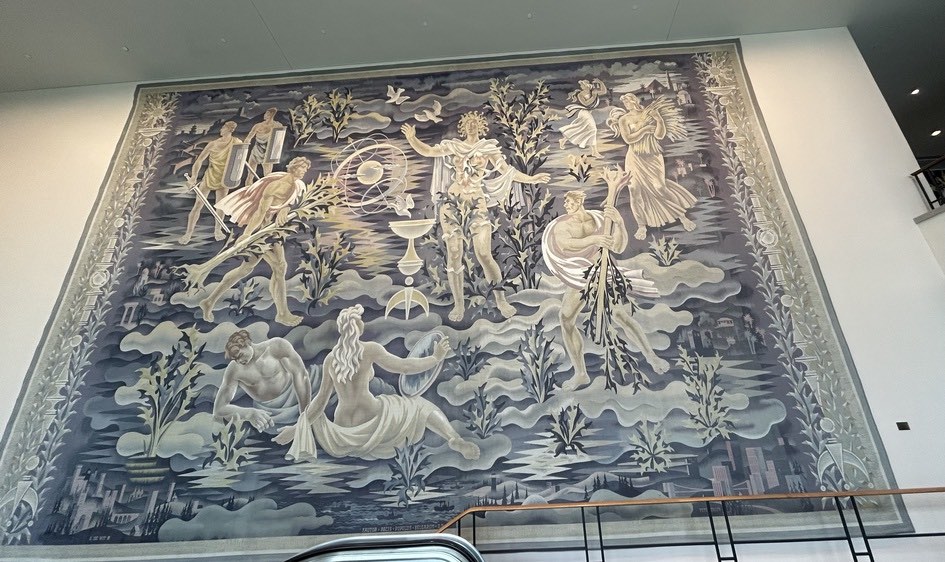
At the lobby of the UN Hospitality office where we were huddled before our tour stands the lofty wood sculpture of the late National Artist Napoleon Abueva. Donated on June 12, 1984, Structures is a statue made of interlocked ipil wood, which, for me, symbolizes strength and harmony. It is one of the two gifts our country bequeathed to the UN, the second being Manuel Baldemor’s painting, Philippine Skyline. As we stopped by the Security Council chamber where it hangs, I was requested to say something about the painting. I opined that Baldemor apparently took inspiration from our famed Banaue rice terraces during a time of harvest as shown by a couple pounding rice using the traditional mortar and pestle. I added that it is reflective of an age-old tradition and our penchant for fiestas when we worship, sing, and dance to celebrate our bounties. Across Baldemor’s painting are twin gifts from Ukraine: an elaborate multi-colored carpet neatly tucked on the wall and an intricately crafted vibrant vase beside it.
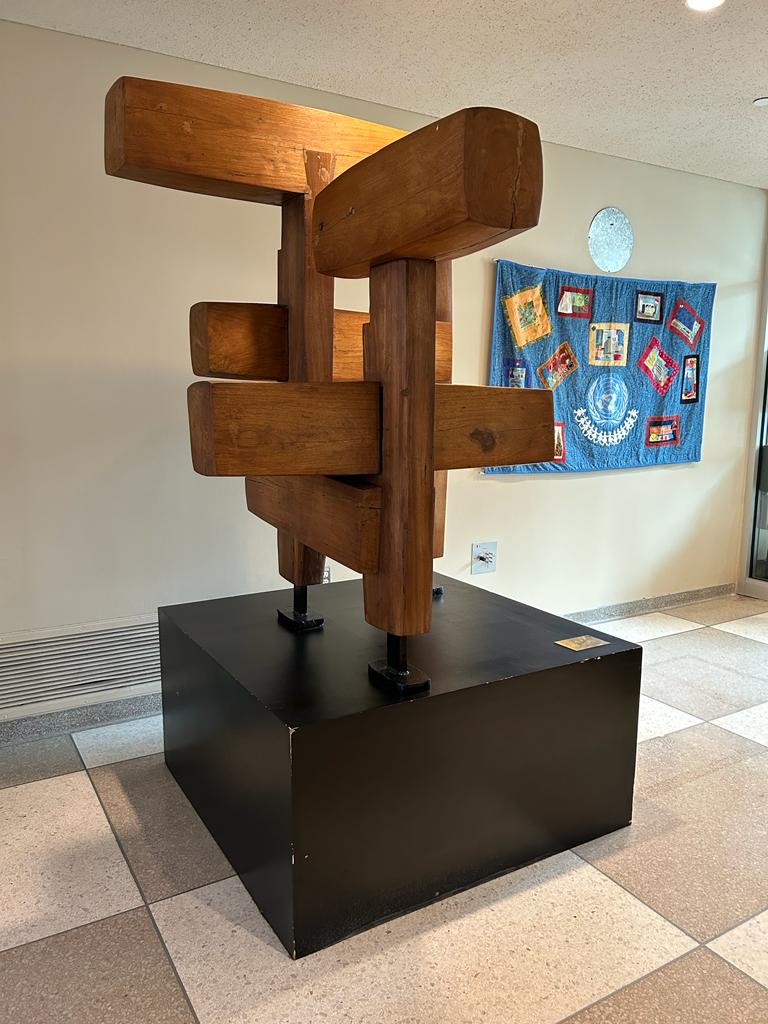
Along the halls leading to the conference rooms are major replicas of the oldest known law or the Code of Hammurabi; the Edict of Cyprus, the oldest known human rights document; the Egyptian-Hittite peace treaty supposedly the oldest known peace accord signed by Ramses II and the first diplomatic immunity, a sort of “get out of jail” card, as our guide described it. There also stands the slender and mystifying Anyanwu: Awakening, the Nigerian sculpture’s Ben Enwonwu’s visualization of Africa Rising. By the spacious delegates' lounge hang huge murals from Iran, Columbia, Romania with a tapestry of the Great Wall of China as one of the most eye-catching.
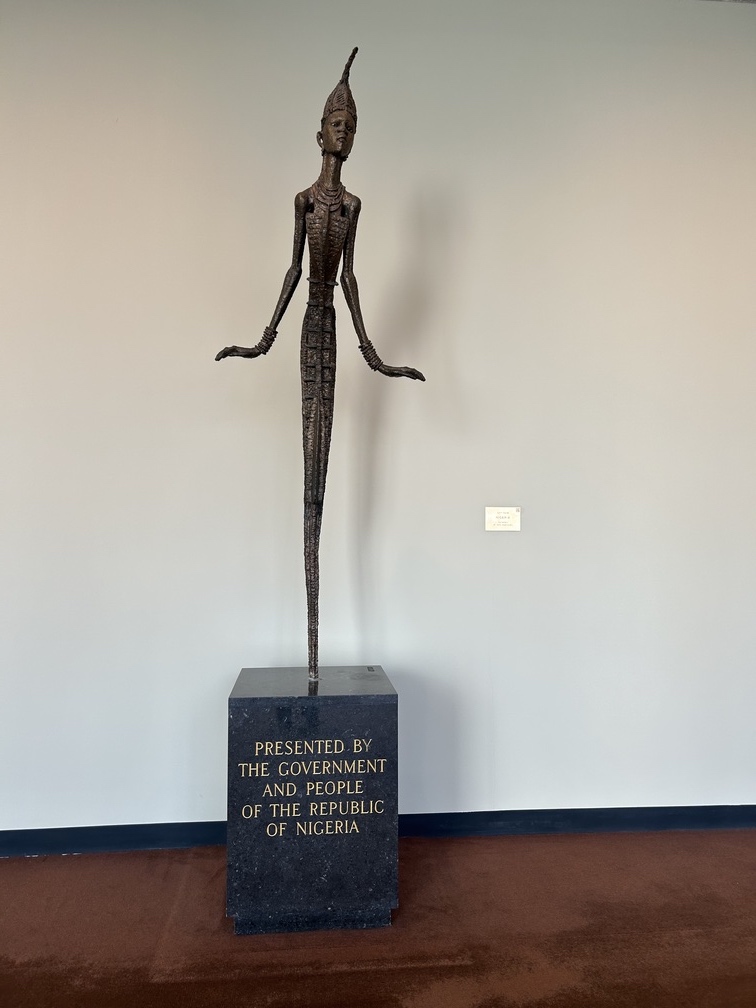
On the third floor near the elevators is the captivating psychedelic mosaic, The Golden Rule, which is made of more than 10,000 ceramic tiles, based on the painting of American artist Norman Rockwell. It is a gift from former First Lady Nancy Reagan that portrays humanity’s common desire for an interfaith and ecumenical spirit among people. The great Pablo Picasso is also represented in the UN through a tapestry of his legendary Guernica, the iconic anti-war painting of the celebrated Spanish artist. We learned that the striking tapestry set in dominant earth colors is customarily used as a backdrop when high-ranking officials and diplomats deliver statements to the press.
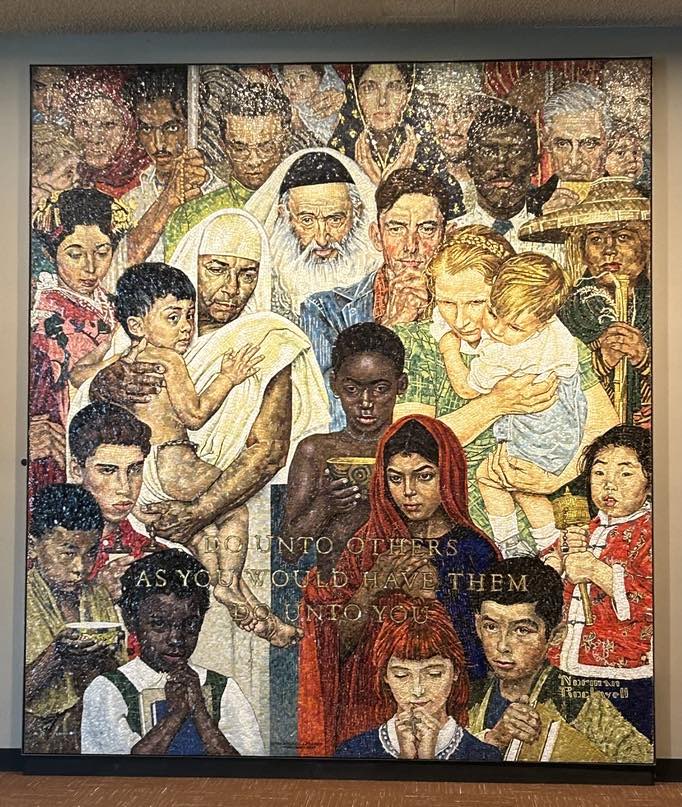
How some rooms and entrances are named is a story of its own. Indonesia, Turkey, and Qatar rooms are called such because they provided the funding for the renovation and upkeep of these spaces. These common areas adorned with art collections are where delegates and diplomats convene in between sessions. We were also briefed that the renovation of the Security Council chamber was taken care of by the Nordic countries. While the public is not allowed to enter this room, it was mentioned that a mural painted by a Norwegian artist representing the aspirations of the UN, accentuates the chamber. And there is actually a Canadian entrance, a row of seven doors made of nickel material donated by the Canadian government. These doors serve as entrances to the public and guests attending the tour of the UN.
Upon entering the Canadian gate, one is greeted by a robust sculpture of a smiling Nelson Mandela, who unquestionably remains to be one of the most recognizable models of peace. I think of Mandela as the most fitting icon to welcome visitors to the UN. Still at the far left end of the same hall is the exuberant Brotherhood by Mexican artist Rufino Tamayo. Rendered in oil with silhouettes encircling a blazing fire, the mural is said to be the artist’s rendition of unity, while fire for Tamayo symbolizes love. It is estimated to cost around $35 million (P1.9 billion) now.
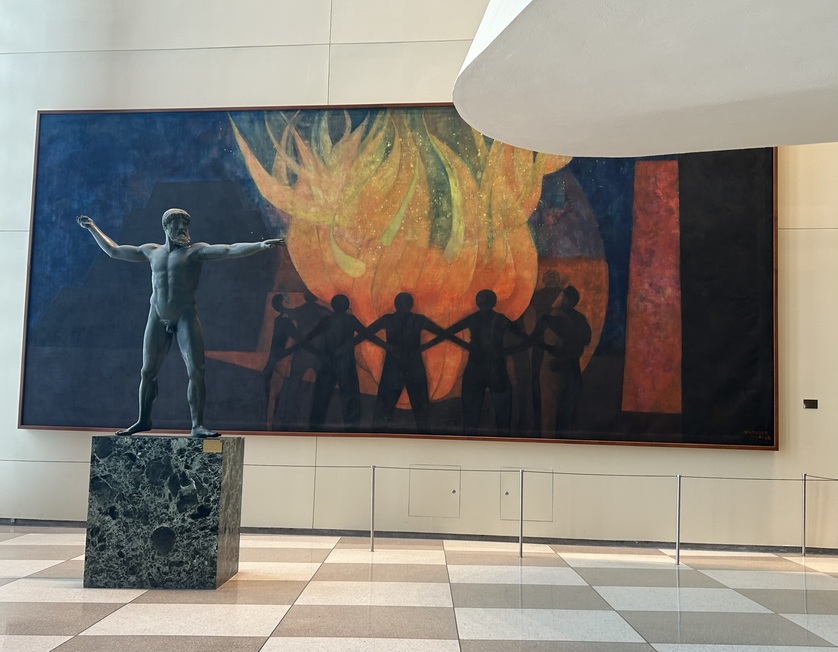
Fixed at the wall sandwiched by the meditation room (a project of Dag Hammarskjold that serves as a place of respite for UN personnel and delegates) and the wall where a torn UN flag is framed (retrieved from the bombing site of the UN headquarters in Baghdad) is the stained-glass work of French Jewish artist Marc Chagall. Chagall had a great admiration for Hammarskjold who as a statesman championed “engaged spirituality.” The striking blue glass masterpiece takes inspiration from the Bible and serves as a memorial to honor the life of Hammarskjold and the 15 UN peacekeepers that perished with him in a plane crash en route to a peace mission in Congo. The lights that illumine the stained glass are currently turned off due to the defective panels. The UN arts committee is still in the process of having the panels repaired. We were told that refurbishing artworks would require approval from the donor country or the foundation or heirs of artists that donated them. Similarly relocating artworks from their original location to another site in the UN also requires authorization from the donor.

Out in the gardens are equally remarkable works and symbolic mementos such as a colorful slab of the Berlin Wall and the Japanese Peace Bell (the original being in Hiroshima), said to be made of coins collected from various member states, the Pope, and some children. The bell is traditionally rung every Sept. 21 to commemorate the International Day of Peace and on every first day of spring. A boat sculpture with people coming down the planks entitled Arrival illustrates Irish migration while the powerful monument Good Defeats Evil is a tribute to nuclear disarmament. Within the grounds where the towering UN flag is hoisted are a few more stunning pieces such as the bronze globe, Sphere Within Sphere by the 97-year-old Italian artist Arnaldo Pomodoro. The Pomodoro opus, which can also be seen in the Vatican Museums and other prominent places in the US, is supposed to represent rebirth and hope for a more peaceful world. Non-Violence is a knotted gun sculpture by Carl Frederk Reutersward of Sweden. The artist made it in honor of his friend John Lennon upon the latter’s death from an assassin’s bullet.
While majority of us were not first-timers in the building, being able to glean first-hand information, ask questions and exchange insights gave us a broader understanding of the masterpieces and their backstories. We were one in saying that half a day is not enough to appreciate all the arts in-house but more than enough to equip us with extra knowledge which we could hopefully use the next time we bring family and guests around the UN. I now think of what our National Artist for Dance Alice Reyes mentioned in a recent article on The Philippine STAR about some of our local government officials as “today’s patrons of the arts.” The UN to my mind is a life-long patron of the arts of many countries of the world. And it is through these arts that the organization steadfastly remains an influential herald of peace, hope, and understanding.


